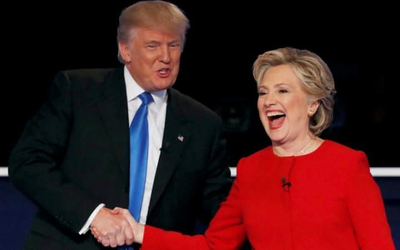On Tuesday Nov 8 2016, 120 million people go to the polls to decide whether Donald Trump or Hillary Clinton will become the 45th President of the United States.
As always, it’s a simple choice between a Republican and a Democrat – although Gary Johnson, the Libertarian candidate, will be hoping to sweep up some votes too.
The system itself, however, is far from simple. Here we make sense of how the US election works.

How does the electoral college work?
All 50 US states and Washington DC have a set number of “electors” in the electoral college – roughly proportionate to the size of each state.
California, the largest state, has 55 electoral votes, while sparsely-populated Wyoming and tiny Washington DC only get only three each.
There are 538 electors and to win a majority and become president either candidate needs to accumulate 270 electors – half the total plus one.
Americans technically vote for electors, not the candidates themselves. The electors are state officials or senior party figures, but they are not usually named on the ballot.
The number of electors each state gets is also equal to the number of seats it has in the House of Representatives and the Senate.
All but two states – Maine and Nebraska – use a winner-takes-all system, so if you win the most votes in a state you take its entire haul of electoral college votes.
The key for either party to win the presidential election is to target specific battleground states. There are several swing states, that over recent elections have gone both ways. They hold the key to winning the election.
What are swing states?
The major swing states in 2016 are Florida, Ohio and Pennsylvania. Other important states include Wisconsin, New Hampshire, Minnesota, Iowa, Michigan, Nevada, Colorado, and North Carolina.
They can be split into three categories:
1. The crown jewels
In recent cycles, the presidency has been won in Florida and Ohio. America’s 3rd and 7th largest states, with 29 and 18 electoral votes respectively, they are constantly swinging back and forth between parties.
The two states also have near-perfect records of picking the president over the past five decades. The result in Ohio has mirrored the national outcome in every election since 1960, while Florida has diverged from the nation at large just once over that period.
It is unsurprising, therefore, that both Mr Trump and Mrs Clinton are focusing a great deal of time and resources on Ohio and Florida.
2. Trump’s must-holds
Because of demographic shifts in the US, paired with Mr Trump’s unpopularity, states that were once solidly Republican are now within reach for the Democrats in 2016.
When Barack Obama won North Carolina in 2008, he was the first Democrat to do so since Jimmy Carter. Mitt Romney won the Southern state back in 2012, and it now appears to be a toss-up between Mrs Clinton and Mr Trump.
The Democratic nominee hopes to expand the map with wins in Arizona, Georgia and Missouri, all of which have consistently voted Republican for nearly two decades.
Because of the realities elsewhere on the map, Mr Trump cannot afford to let those states change hands in 2016.
3. ‘Obama coalition’ holdovers
Mr Obama won the electoral college by wide margins both in 2008 and 2012, and he did so by taking traditional swing states like Iowa and Pennsylvania.
He also helped bring ethnically diverse states like Colorado and Nevada into the Democratic fold.
Lastly he utilised his popularity among suburban voters to turn states like Virginia (and North Carolina) blue.
Mrs Clinton looks likely to hold on to Colorado, Pennyslvania and Virginia, with Iowa and Nevada still hanging in the balance.
She is also facing a stronger-than-expected challenge in New Hampshire, which has voted for the Democrat in every recent election except 2000.
Read more: The Telegraph
Photo credit: REUTERS


